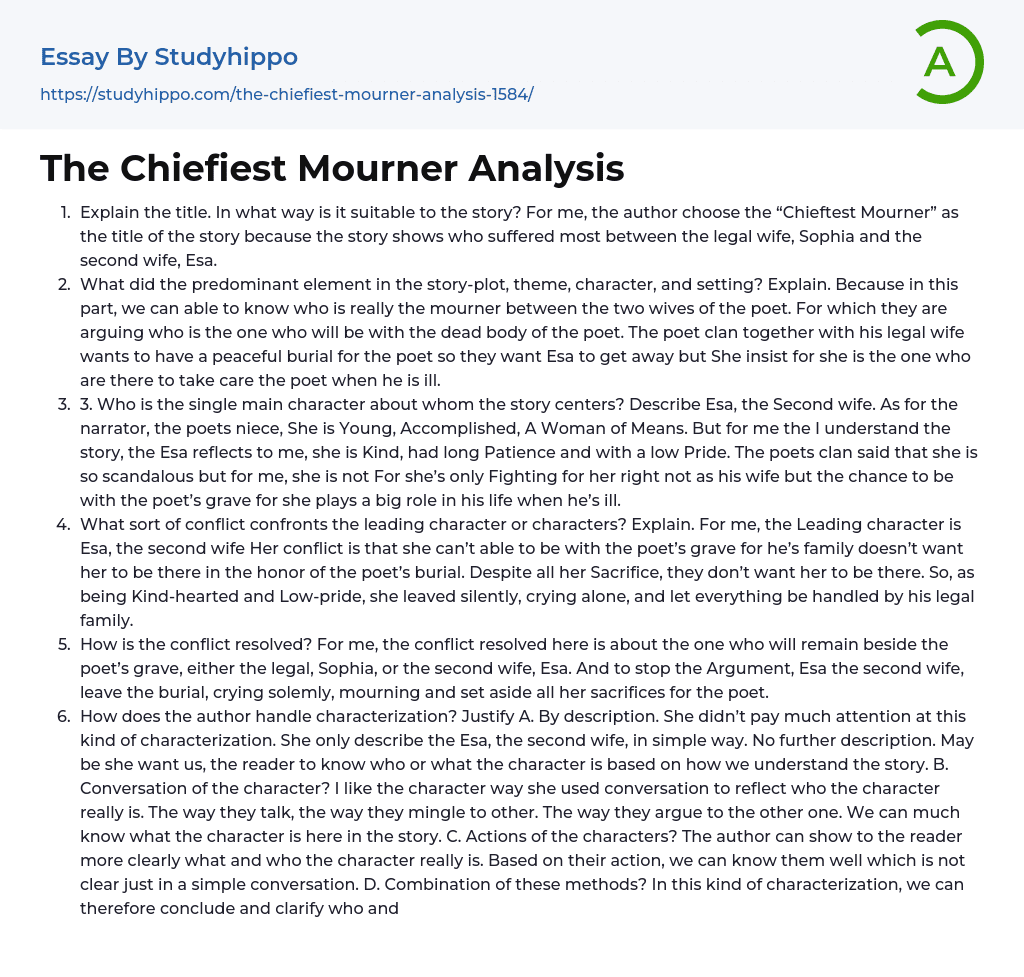- Explain the title. In what way is it suitable to the story? For me, the author choose the “Chieftest Mourner” as the title of the story because the story shows who suffered most between the legal wife, Sophia and the second wife, Esa.
- What did the predominant element in the story-plot, theme, character, and setting? Explain. Because in this part, we can able to know who is really the mourner between the two wives of the poet. For which they are arguing who is the one who will be with the dead body of the poet. The poet clan together with his legal wife wants to have a peaceful burial for the poet so they want Esa to get away but She insist for she is the one who are there to take care the poet when
...he is ill.
- 3. Who is the single main character about whom the story centers? Describe Esa, the Second wife. As for the narrator, the poets niece, She is Young, Accomplished, A Woman of Means. But for me the I understand the story, the Esa reflects to me, she is Kind, had long Patience and with a low Pride. The poets clan said that she is so scandalous but for me, she is not For she’s only Fighting for her right not as his wife but the chance to be with the poet’s grave for she plays a big role in his life when he’s ill.
- What sort of conflict confronts the leading character or characters? Explain. For me, the Leading character is Esa, the second wife Her conflict is that she can’t able to be with
View entire sampleJoin StudyHippo to see entire essay
the poet’s grave for he’s family doesn’t want her to be there in the honor of the poet’s burial. Despite all her Sacrifice, they don’t want her to be there. So, as being Kind-hearted and Low-pride, she leaved silently, crying alone, and let everything be handled by his legal family.
able to know who they are in the story and what role they are holding. Through this characterization, the way they talk the way they act, we can therefore know who really the chieftest mourner is. If it is either Sophia or Esa.
come back and Sophia do nothing to stop him, this is the time when he moved to a hotel and Sophia didn’t came of it.
be there or stay there just for honor, that they didn’t consider all her sacrifices for the poet. In this part, they start arguing whom to be the poet’s grave be with. In this, we also conclude, after revealing each sacrifices, who really suffered most and deserved for the title, the Chieftest Mourner.
each of us. I can’t justify my answer by now for like I said, I didn’t encounter this kind of situation I real life yet.
good things they’ve done. As for the sorry, Sophia must forgive Esa and consider her sacrifices for the poet. She must also give her chance to be there in the burial for she is the one whose there when the poet is ill.
me, Esa is the dynamic character she didn’t sit quietly in the corner of the Burial and let them Bully her. But for the honor of poet’s burial, she just walk away and leave everything aside
- Boo Radley essays
- Genesis essays
- Richard iii essays
- Alice in Wonderland essays
- On the road essays
- Ozymandias essays
- The Nightingale essays
- Holden Caulfield essays
- Animal Farm essays
- 1984 essays
- A Hanging essays
- Shooting An Elephant essays
- A Tale Of Two Cities essays
- Adventures Of Huckleberry Finn essays
- Arthur Conan Doyle essays
- Brave New World essays
- Characters In Hamlet essays
- Characters In Romeo And Juliet essays
- Desdemona essays
- Diary Of A Wimpy Kid essays
- First-Person Narrative essays
- Frankenstein essays
- Heart Of Darkness essays
- Jane Eyre essays
- Jay Gatsby essays
- King Duncan essays
- Librarian essays
- Little Red Riding Hood essays
- Lord Of The Flies essays
- Silas Marner essays
- The Cask Of Amontillado essays
- The Catcher In The Rye essays
- The Crucible essays
- The Handmaid's Tale essays
- The Reader essays
- Virgil essays
- Wuthering Heights essays
- Candide essays
- Castle essays
- J. D. Salinger essays
- Ulysses essays
- Ethan Frome essays
- In Cold Blood essays
- Outliers essays
- Tuesdays With Morrie essays
- The Art of War essays
- Wife of Bath essays
- Huckleberry Finn essays
- The Lady With The Dog essays
- Great Expectations essays




